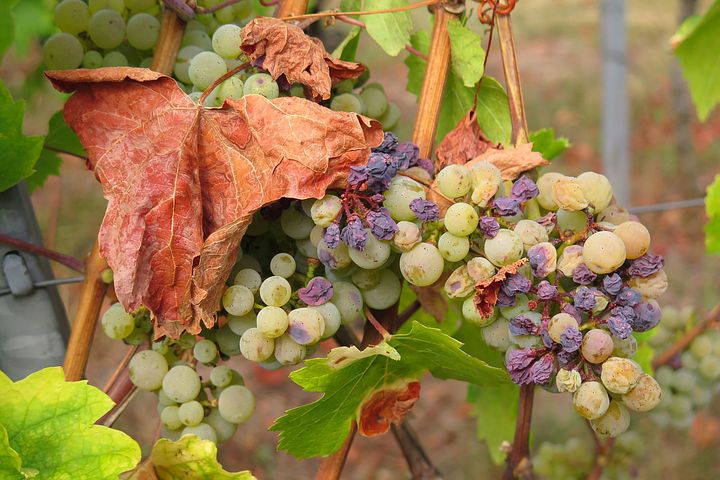Ecologische regen op aanvraag
- LucaDeroma
- ShaunyVan Hoye
- BrentVanvyaene
Drie op tien mensen ter wereld hebben momenteel geen toegang tot veilig en schoon water. Zelfs in België is waterschaarste een actueel probleem. Waarom dan geen oplossing zoeken om het meer te laten regenen?
Te weinig regen?
Momenteel gaat er geen dag voorbij of er staat een artikel in de krant over het grondwatertekort in België of de extreme droogte. Om toch een extra hoeveelheid neerslag te krijgen, maakt men in landen zoals China gebruik van cloud seeding, waarbij bepaalde chemische middelen, voornamelijk zilverjodide (AgI), in wolken verspreid worden.
 Deze deeltjes zorgen voor extra kernen waarop ijsvorming of condensatie kan optreden. Dit kan niet enkel gebruikt worden om regen te induceren, maar ook om oogsten te beschermen tegen zware hagelstormen, extra sneeuw te creëren in skigebieden en mist op luchthavens te verminderen.
Deze deeltjes zorgen voor extra kernen waarop ijsvorming of condensatie kan optreden. Dit kan niet enkel gebruikt worden om regen te induceren, maar ook om oogsten te beschermen tegen zware hagelstormen, extra sneeuw te creëren in skigebieden en mist op luchthavens te verminderen. Men kan zich natuurlijk afvragen of deze chemicaliën nu echt de meest efficiënte en meest veilige zijn in gebruik, want natuurlijke neerslag wordt uiteraard niet gevormd door menselijke moleculen. Onderzoek heeft al aangetoond dat grote hoeveelheden van zilverjodide schadelijk kunnen zijn voor zowel ecosystemen als voor de gezondheid van mensen. Daarom was ons idee om hier een biodegradeerbaar, niet-toxisch alternatief voor te zoeken.
Men kan zich natuurlijk afvragen of deze chemicaliën nu echt de meest efficiënte en meest veilige zijn in gebruik, want natuurlijke neerslag wordt uiteraard niet gevormd door menselijke moleculen. Onderzoek heeft al aangetoond dat grote hoeveelheden van zilverjodide schadelijk kunnen zijn voor zowel ecosystemen als voor de gezondheid van mensen. Daarom was ons idee om hier een biodegradeerbaar, niet-toxisch alternatief voor te zoeken.
De internationale competitie iGEM
Het idee kwam ter sprake toen we aan het denken waren over een project om deel te nemen aan iGEM (International Genetically Engineered Machine). Dit is een wereldwijde wedstrijd waar studenten oplossingen zoeken voor actuele problemen en deze proberen op te lossen met behulp van synthetische biologie. Aangezien één van de Sustainable Development Goals van de UN gaat over waterschaarste, vroeg iemand zich af waarom we het niet ‘gewoon’ extra konden laten regenen. Zo ontstond het idee om een alternatief middel voor cloud seeding te ontwikkelen. Het idee is al zeer enthousiast ontvangen!
Ons project: 'Vsycle'
De naam van het product dat we willen ontwikkelen is ‘Vsycle’. Vscyle bestaat uit een vesikel waarop ijskiemproteïnen, INPs (Ice Nucleation Proteins) zijn gebonden. Vesikels zijn kleine blaasjes, afgescheiden door cellen, die stoffen bevatten en omgeven worden door een membraan. De functie hiervan is het opslaan of het transporteren van bepaalde stoffen tussen en in cellen. INPs werken dan weer omdat ze wateraantrekkende en waterafstotende regio’s bevatten waardoor watermoleculen zo aangetrokken worden dat een structuur gelijkend op een ijskristal bereikt wordt. Het voordeel ten opzichte van de huidige methoden is dat de vesikels met INPs ook daadwerkelijk biologisch afbreekbaar en niet giftig zijn. Bovendien is aangetoond dat de INPs een hogere efficiëntie hebben als wolkcondensatiekern in vergelijking met de chemicaliën die vandaag de dag gebruikt worden in cloud seeding. De INPs komen ook van nature voor in wolken waar ze geproduceerd worden door bacteriën. De INPs zijn aan hun oppervlak gebonden. Uit ander onderzoek is ook gebleken dat de INPs daadwerkelijk efficiënter zijn wanneer ze aan een oppervlak worden gebonden in vergelijking met een oplosbaar eiwit.
Het 'productieproces'
Voor de productie van Vsycle zal de meest veelbelovende INP-producerende kandidaat worden geselecteerd die een eenvoudig en efficiënt expressiesysteem heeft om INP's functioneel tot expressie te brengen via een vesikel. Deze keuze zal bepaald worden met behulp van literatuur en metagenomische gegevens (uit de studie van rechtstreeks uit omgevingsmonsters gewonnen genetisch materiaal) van monsters uit wolken te onderzoeken. Vervolgens zal een nieuw expressiesysteem worden ontwikkeld om INPs op een vesikel weer te geven. Een dergelijk systeem heeft het voordeel dat INPs membraangebonden zijn, wat de ijskiemactiviteit van INPs verhoogt in vergelijking met oplosbare INPs. Bovendien zal het herstel van deze vesikels met INPs uit celculturen het mogelijk maken om het gebruik van GGO's en de bijbehorende risico's, wetgeving en negatieve publieke perceptie te vermijden. Ten slotte zal een stroomafwaarts proces worden ontwikkeld en geoptimaliseerd om de vesikels te herstellen. Omdat deze vesikels verschillen van de bacterie-celgrootte, worden (ultra)centrifugatie- en filtratiestappen toegepast. Daarnaast zal, op basis van het hydrofobe karakter van de vesikels, ook zuivering door fasescheiding worden gebruikt.
Testen van de activiteit
De efficiëntie van ijskiemactiviteit van INPs wordt over het algemeen getest door te kijken naar de laagste temperatuur onder nul waarbij onderkoeld water, dat normaal nog vloeibaar is bij temperaturen ver onder 0°C (tot -35°C), begint te bevriezen. In de praktijk gebeurt dit door middel van een druppelbevriezingstest. Bij deze test worden ijskernen toegevoegd aan een aantal waterdruppels bij verschillende temperaturen en temperaturen waarbij de meeste kernen bevriezen. Het doel is om in een later stadium het effect van de vesikels als cloud seeding middel te testen. Om dit te onderzoeken wordt er een wolk gemaakt in een gecontroleerde isotherme kamer en worden de effecten van het toevoegen van de middelen waargenomen.
Is Vsycle dan geen GGO?
Door wetgeving met betrekking tot GGO's is het vrij moeilijk om genetisch gemodificeerde bacteriën vrij te laten. Daarom zullen we Vsycle creëren als een niet-levend vesikel met gebonden INPs die geen DNA of celcompartimenten bevat. Op die manier worden er eigenlijk geen GGO’s in de natuur gebracht.
Extra toepassingen?
Op basis van ons vooronderzoek zijn wij als team van mening dat Vsycle niet alleen een beter presterend, niet-giftig en biologisch afbreekbaar alternatief is voor de huidige cloud seeding middelen. Vanwege zijn eigenschappen kan het worden gebruikt voor een breder scala aan toepassingen, zoals het voorkomen van overstromingen en het verstrekken van extra regen aan droge ecosystemen die op het punt staan in te storten als gevolg van klimaatverandering. Dit zou duizenden - zo niet miljoenen - soorten kunnen redden in plaatsen als de Sahel en Australië, maar uiteindelijk over de hele wereld. Het Vsycle cloud seeding-initiatief heeft tot doel 15-30% extra regen te brengen waar het wordt gebruikt om regen op te wekken. Deze extra percentages kunnen het verschil betekenen tussen het overleven of uitsterven van een soort. We hopen dat Vsycle een stap zou kunnen zijn in de richting van herstel van ecosystemen die door klimaatverandering te lijden hebben onder droogte. Dit komt alle soorten organismen ten goede, van insecten tot zoogdieren en planten.

There are no secrets about the world of nature. There are secrets about the thoughts and intentions of men - J. Robert Oppenheimer
Bibliografie
AQUASTAT (2014). Water scarcity. https://www.unwater.org/water-facts/scarcity/. Ac- cessed on 2020-04-03.
Aqueduct (2019). 17 countries, home to one-quarter of the world’s population, face extremely high water stress. https://www.wri.org/blog/2019/08/17-countries-home- one-quarter-world-population-face-extremely-high-water-stress. Accessed on 2020- 05-25.
Ashraf, H. (2003). Experts gather to discuss water crisis that the world is ignoring. The Lancet, 361(9361):935.
Awn Nanotech Inc. (2018). Awn nanotech product. http://awnnanotech.com/. Ac- cessed on 2020-04-03.
Baertlein, D. A., Lindow, S. E., Panopoulos, N. J., Lee, S. P., Mindrinos, M. N., and Chen, T. H. (1992). Expression of a bacterial ice nucleation gene in plants. Plant physiology, 100(4):1730–1736.
Beasley, C. (2009). Precipitation and intro to radar, ats 351, lecture 7. https://slideplayer.com/slide/8148366/. Accessed on 2020-04-03.
Bruintjes, R. T. (1999). A review of cloud seeding experiments to enhance precipi- tation and some new prospects. Bulletin of the American Meteorological Society, 80(5):805–820.
Buttner, M. P. and Amy, P. S. (1989). Survival of ice nucleation-active and genetically engineered non-ice-nucleating pseudomonas syringae strains after freezing. Appl. Environ. Microbiol., 55(7):1690–1694.
Choo, S., Choi, H.-J., and Lee, H. (2015). Water-collecting behavior of nanostructured surfaces with special wettability. Applied Surface Science, 324:563–568.
Chubb, T. (2020). Mail: ’cloud seeding program’. Contacted on 2020-05-01.
Cid, F. P., Rilling, J. I., Graether, S. P., Bravo, L. A., Mora, M. d. L. L., and Jorquera, M. A. (2016). Properties and biotechnological applications of ice-binding proteins in bacteria. FEMS microbiology letters, 363(11):fnw099.
Comanns, P. (2018). Passive water collection with the integument: mechanisms and
their biomimetic potential. Journal of Experimental Biology, 221(10):jeb153130.
Davies, P. L., Baardsnes, J., Kuiper, M. J., and Walker, V. K. (2002). Structure and function of antifreeze proteins. Philosophical Transactions of the Royal Society of London. Series B: Biological Sciences, 357(1423):927–935.
Dennis, A. S. (1980). Weather modification by cloud seeding. International geophysics series, 24.
Fajardo, C., Costa, G., Ortiz, L., Nande, M., Rodríguez-Membibre, M., Martín, M., and Sánchez-Fortún, S. (2016). Potential risk of acute toxicity induced by agi cloud seed- ing on soil and freshwater biota. Ecotoxicology and environmental safety, 133:433– 441.
FAO (2020). Water. http://www.fao.org/water/en/. Accessed on 2020-04-22.
Gadgil, A. (1998). Drinking water in developing countries. Annual review of energy
and the environment, 23(1):253–286.
Garnham, C. P., Campbell, R. L., Walker, V. K., and Davies, P. L. (2011). Novel dimeric β-helical model of an ice nucleation protein with bridged active sites. BMC structural biology, 11(1):36.
Govindarajan, A. G. and Lindow, S. E. (1988). Size of bacterial ice-nucleation sites measured in situ by radiation inactivation analysis. Proceedings of the National Academy of Sciences, 85(5):1334–1338.
Graether, S. P. and Jia, Z. (2001). Modeling pseudomonas syringae ice-nucleation protein as a β-helical protein. Biophysical journal, 80(3):1169–1173.
Gurian-Sherman, D. and Lindow, S. E. (1993). Bacterial ice nucleation: significance and molecular basis. The FASEB journal, 7(14):1338–1343.
Han, Y. J., Song, H., Lee, C. W., Ly, N. H., Joo, S.-W., Lee, J. H., Kim, S.-J., and Park, S. (2017). Biophysical characterization of soluble pseudomonas syringae ice nu- cleation protein inaz fragments. International journal of biological macromolecules, 94:634–641.
iGEM Foundation (2020). igem: International genetically engineered machine. https://igem.org. Accessed on 2020-04-03.
Joly, M., Attard, E., Sancelme, M., Deguillaume, L., Guilbaud, C., Morris, C. E., Amato, P., and Delort, A.-M. (2013). Ice nucleation activity of bacteria isolated from cloud water. Atmospheric environment, 70:392–400.
Kajava, A. V. and Lindow, S. E. (1993). A model of the three-dimensional structure of ice nucleation proteins.
Kalmutzki, M. J., Diercks, C. S., and Yaghi, O. M. (2018). Metal–organic frameworks for water harvesting from air. Advanced Materials, 30(37):1704304.
Kassmannhuber, J., Rauscher, M., Schöner, L., Witte, A., and Lubitz, W. (2017). Func- tional display of ice nucleation protein inaz on the surface of bacterial ghosts. Bio- engineered, 8(5):488–500.
Kim, H., Rao, S. R., Kapustin, E. A., Zhao, L., Yang, S., Yaghi, O. M., and Wang, E. N. (2018). Adsorption-based atmospheric water harvesting device for arid climates. Nature communications, 9(1):1–8.
Kim, H., Yang, S., Rao, S. R., Narayanan, S., Kapustin, E. A., Furukawa, H., Umans, A. S., Yaghi, O. M., and Wang, E. N. (2017). Water harvesting from air with metal-organic frameworks powered by natural sunlight. Science, 356(6336):430–434.
Kozloff, L., Turner, M., and Arellano, F. (1991). Formation of bacterial membrane ice- nucleating lipoglycoprotein complexes. Journal of bacteriology, 173(20):6528–6536.
Kumaki, Y., Kawano, K., Hikichi, K., Matsumoto, T., and Matsushima, N. (2008). A circular loop of the 16-residue repeating unit in ice nucleation protein. Biochemical and biophysical research communications, 371(1):5–9.
Lee, S. J., Ha, N., and Kim, H. (2019). Superhydrophilic–superhydrophobic water har- vester inspired by wetting property of cactus stem. ACS Sustainable Chemistry & Engineering, 7(12):10561–10569.
Levin, Z., Yankofsky, S., Pardes, D., and Magal, N. (1987). Possible application of bacterial condensation freezing to artificial rainfall enhancement. Journal of climate and applied meteorology, 26(9):1188–1197.
Li, Q., Yan, Q., Chen, J., He, Y., Wang, J., Zhang, H., Yu, Z., and Li, L. (2012). Molecular characterization of an ice nucleation protein variant (inaq) from pseudomonas sy- ringae and the analysis of its transmembrane transport activity in escherichia coli. International journal of biological sciences, 8(8):1097.
Lindow, S. (1983). Kinetics of changes in ice nucleation activity of pseudomonas- syringae following temperature shifts. In Phytopathology, volume 73, pages 809– 809. AMER PHYTOPATHOLOGICAL SOC 3340 PILOT KNOB ROAD, ST PAUL, MN 55121.
Ling, M., Wex, H., Grawe, S., Jakobsson, J., Löndahl, J., Hartmann, S., Finster, K.,
ˇ
Boesen, T., and Santl-Temkiv, T. (2018). Effects of ice nucleation protein repeat
number and oligomerization level on ice nucleation activity. Journal of Geophysical Research: Atmospheres, 123(3):1802–1810.
Malik, S., Bano, H., Rather, R. A., and Ahmad, S. (2018). Cloud seeding; its prospects
and concerns in the modern world-a review. Int. J. Pure App. Biosci, 6(5):791–796.
Marcolli, C., Nagare, B., Welti, A., and Lohmann, U. (2016). Ice nucleation efficiency of agi: review and new insights. Atmospheric Chemistry and Physics, 16(14):8915– 8937.
McDonald, J. E. (1958). The physics of cloud modification. Advances in Geophysics, 5:223–303.
Morris, C., Georgakopoulos, D., and Sands, D. (2004). Ice nucleation active bacteria and their potential role in precipitation. In Journal de Physique IV (Proceedings), volume 121, pages 87–103. EDP sciences.
Mozumder, M. S., Mourad, A.-H. I., Pervez, H., and Surkatti, R. (2019). Recent devel- opments in multifunctional coatings for solar panel applications: A review. Solar Energy Materials and Solar Cells, 189:75–102.
Nemecek-Marshall, M., Laduca, R., and Fall, R. (1993). High-level expression of ice nuclei in a pseudomonas syringae strain is induced by nutrient limitation and low temperature. Journal of bacteriology, 175(13):4062–4070.
Newby, J. (2017). How does a snow machine work? Cosmos, (75).
Nune, S. K., Lao, D. B., Heldebrant, D. J., Liu, J., Olszta, M. J., Kukkadapu, R. K., Gordon, L. M., Nandasiri, M. I., Whyatt, G., Clayton, C., et al. (2016). Anomalous water expul- sion from carbon-based rods at high humidity. Nature nanotechnology, 11(9):791.
Panel, I. R., Consumption, U. N. E. P. S., and Branch, P. (2011). Decoupling natural resource use and environmental impacts from economic growth. UNEP/Earthprint.
Parker, A. R. and Lawrence, C. R. (2001). Water capture by a desert beetle. Nature, 414(6859):33.
Pelley, J. (2016). Does cloud seeding really work. Chemical and Engineering News, 94(22):18–21.
Phelps, P., Giddings, T. H., Prochoda, M., and Fall, R. (1986). Release of cell-free ice nuclei by erwinia herbicola. Journal of bacteriology, 167(2):496–502.
Qiu, Y., Hudait, A., and Molinero, V. (2019). How size and aggregation of ice-binding proteins control their ice nucleation efficiency. Journal of the American Chemical Society, 141(18):7439–7452.
Rosenfeld, D., Axisa, D., Woodley, W. L., and Lahav, R. (2010). A quest for effec- tive hygroscopic cloud seeding. Journal of applied meteorology and climatology, 49(7):1548–1562.
Schlesinger, W. H. and Jasechko, S. (2014). Transpiration in the global water cycle.
Agricultural and Forest Meteorology, 189:115–117.
Schmid, D., Pridmore, D., Capitani, G., Battistutta, R., Neeser, J.-R., and Jann, A. (1997). Molecular organisation of the ice nucleation protein inav from pseudomonas syringae. FEBS letters, 414(3):590–594.
Serageldin, A. A., K.abdelrahman, A., Ali, Prof. Dr. Eng, A. H. H., Ali, M., and Ookawara, S. (2015). Soil temperature profile for some new cities in egypt: Experimental results and mathematical model.
Service, R. F. (2017). This new solar-powered device can pull water straight from the desert air. https://www.sciencemag.org/news/2017/04/new-solar-powered-device- can-pull-water-straight-desert-air. Accessed on 2020-04-03.
Shiklomanov, I. A. (1991). The world’s water resources. In International symposium to commemorate the, volume 25, pages 93–105.
Siems, S. (2020). Mail: ’info around cloud seeding’. Contacted on 2020-04-29.
Silverman, B. A. (2001). A critical assessment of glaciogenic seeding of convective clouds for rainfall enhancement. Bulletin of the American Meteorological Society, 82(5):903–924.
Snomax (2015). Snomax international. http://www.snomax.com. Accessed on 2020- 04-03.
Statbel (2019). Twee derde van het belgisch grondgebied bestaat uit landbouwgrond en bos. https://statbel.fgov.be/nl/themas/leefmilieu/grond/bodemgebruiknews. Ac- cessed on 2020-04-03.
The Australian Museum (2018). Green tree frog. https://australianmuseum.net.au/learn/animals/frogs/green-tree-frog/. Accessed on 2020-04-03.
Trapani, F., Polyzoidis, A., Loebbecke, S., and Piscopo, C. (2016). On the general wa- ter harvesting capability of metal-organic frameworks under well-defined climatic conditions. Microporous and Mesoporous Materials, 230:20–24.
UGent Belgium iGEM 2016 (2016). Dewpal. http://2016.igem.org/Team:UGent Bel- gium. Accessed on 2020-04-03.
UN (2015). Sustainable development goals. https://sustainabledevelopment.un.org. Accessed on 2020-04-03.
Ward, P. J. and DeMott, P. J. (1989). Preliminary experimental evaluation of snomax (tm) snow inducer, nucleus pseudomonas syringae, as an artificial ice for weather modification. The Journal of Weather Modification, 21(1):9–13.
Yankofsky, S., Levin, Z., Bertold, T., and Sandlerman, N. (1981). Some basic character- istics of bacterial freezing nuclei. Journal of applied meteorology, 20(9):1013–1019.
Zhang, S., Wang, H., and Chen, G. (2010). Addition of ice-nucleation active bacteria: Pseudomonas syringae pv. panici on freezing of solid model food. LWT-FOOd science and Technology, 43(9):1414–1418.









